warning DODGE DART 2014 PF / 1.G Owner's Manual
[x] Cancel search | Manufacturer: DODGE, Model Year: 2014, Model line: DART, Model: DODGE DART 2014 PF / 1.GPages: 656, PDF Size: 4.73 MB
Page 63 of 656
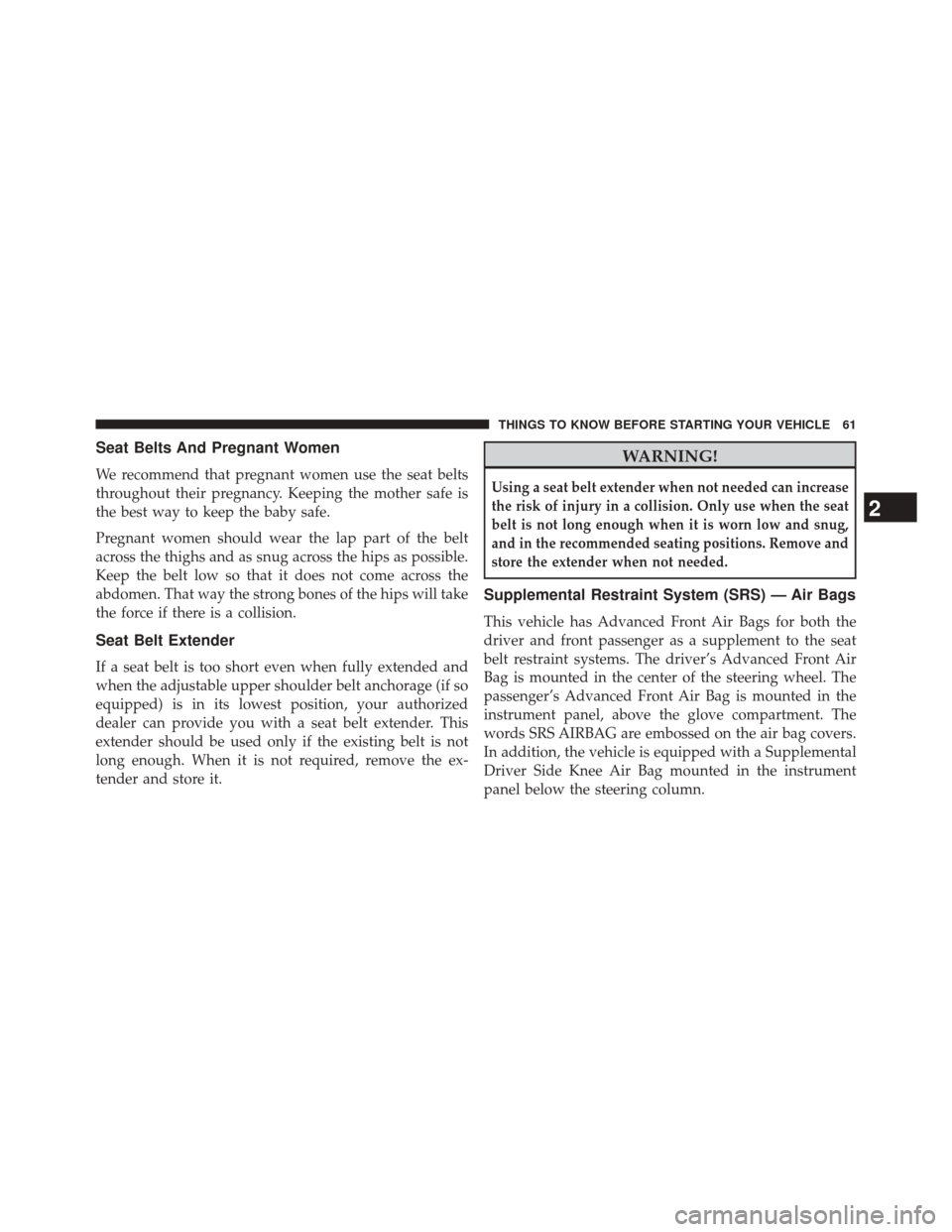
Seat Belts And Pregnant Women
We recommend that pregnant women use the seat belts
throughout their pregnancy. Keeping the mother safe is
the best way to keep the baby safe.
Pregnant women should wear the lap part of the belt
across the thighs and as snug across the hips as possible.
Keep the belt low so that it does not come across the
abdomen. That way the strong bones of the hips will take
the force if there is a collision.
Seat Belt Extender
If a seat belt is too short even when fully extended and
when the adjustable upper shoulder belt anchorage (if so
equipped) is in its lowest position, your authorized
dealer can provide you with a seat belt extender. This
extender should be used only if the existing belt is not
long enough. When it is not required, remove the ex-
tender and store it.
WARNING!
Using a seat belt extender when not needed can increase
the risk of injury in a collision. Only use when the seat
belt is not long enough when it is worn low and snug,
and in the recommended seating positions. Remove and
store the extender when not needed.
Supplemental Restraint System (SRS) — Air Bags
This vehicle has Advanced Front Air Bags for both the
driver and front passenger as a supplement to the seat
belt restraint systems. The driver’s Advanced Front Air
Bag is mounted in the center of the steering wheel. The
passenger’s Advanced Front Air Bag is mounted in the
instrument panel, above the glove compartment. The
words SRS AIRBAG are embossed on the air bag covers.
In addition, the vehicle is equipped with a Supplemental
Driver Side Knee Air Bag mounted in the instrument
panel below the steering column.
2
THINGS TO KNOW BEFORE STARTING YOUR VEHICLE 61
Page 65 of 656
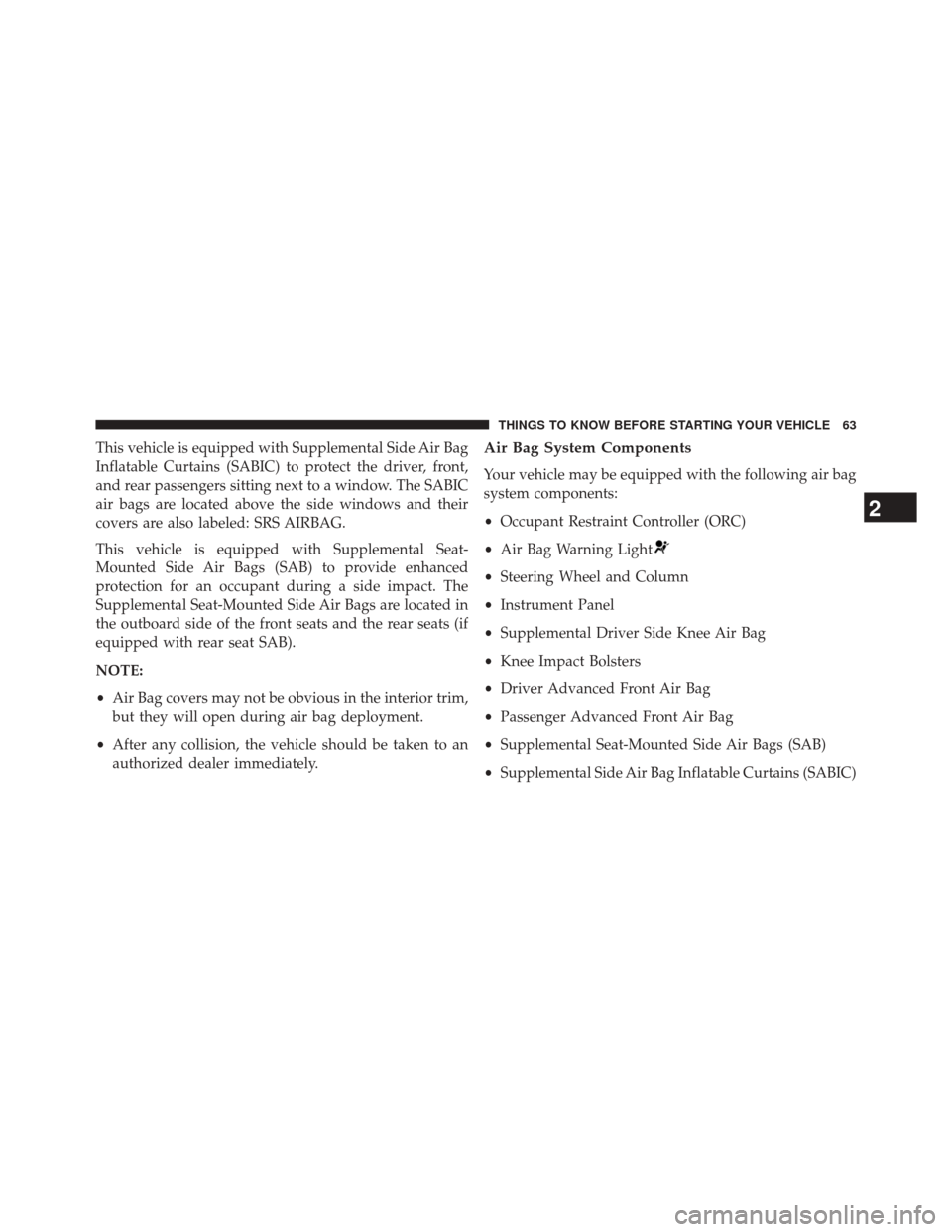
This vehicle is equipped with Supplemental Side Air Bag
Inflatable Curtains (SABIC) to protect the driver, front,
and rear passengers sitting next to a window. The SABIC
air bags are located above the side windows and their
covers are also labeled: SRS AIRBAG.
This vehicle is equipped with Supplemental Seat-
Mounted Side Air Bags (SAB) to provide enhanced
protection for an occupant during a side impact. The
Supplemental Seat-Mounted Side Air Bags are located in
the outboard side of the front seats and the rear seats (if
equipped with rear seat SAB).
NOTE:
•Air Bag covers may not be obvious in the interior trim,
but they will open during air bag deployment.
• After any collision, the vehicle should be taken to an
authorized dealer immediately.Air Bag System Components
Your vehicle may be equipped with the following air bag
system components:
•Occupant Restraint Controller (ORC)
• Air Bag Warning Light
•Steering Wheel and Column
• Instrument Panel
• Supplemental Driver Side Knee Air Bag
• Knee Impact Bolsters
• Driver Advanced Front Air Bag
• Passenger Advanced Front Air Bag
• Supplemental Seat-Mounted Side Air Bags (SAB)
• Supplemental Side Air Bag Inflatable Curtains (SABIC)
2
THINGS TO KNOW BEFORE STARTING YOUR VEHICLE 63
Page 66 of 656
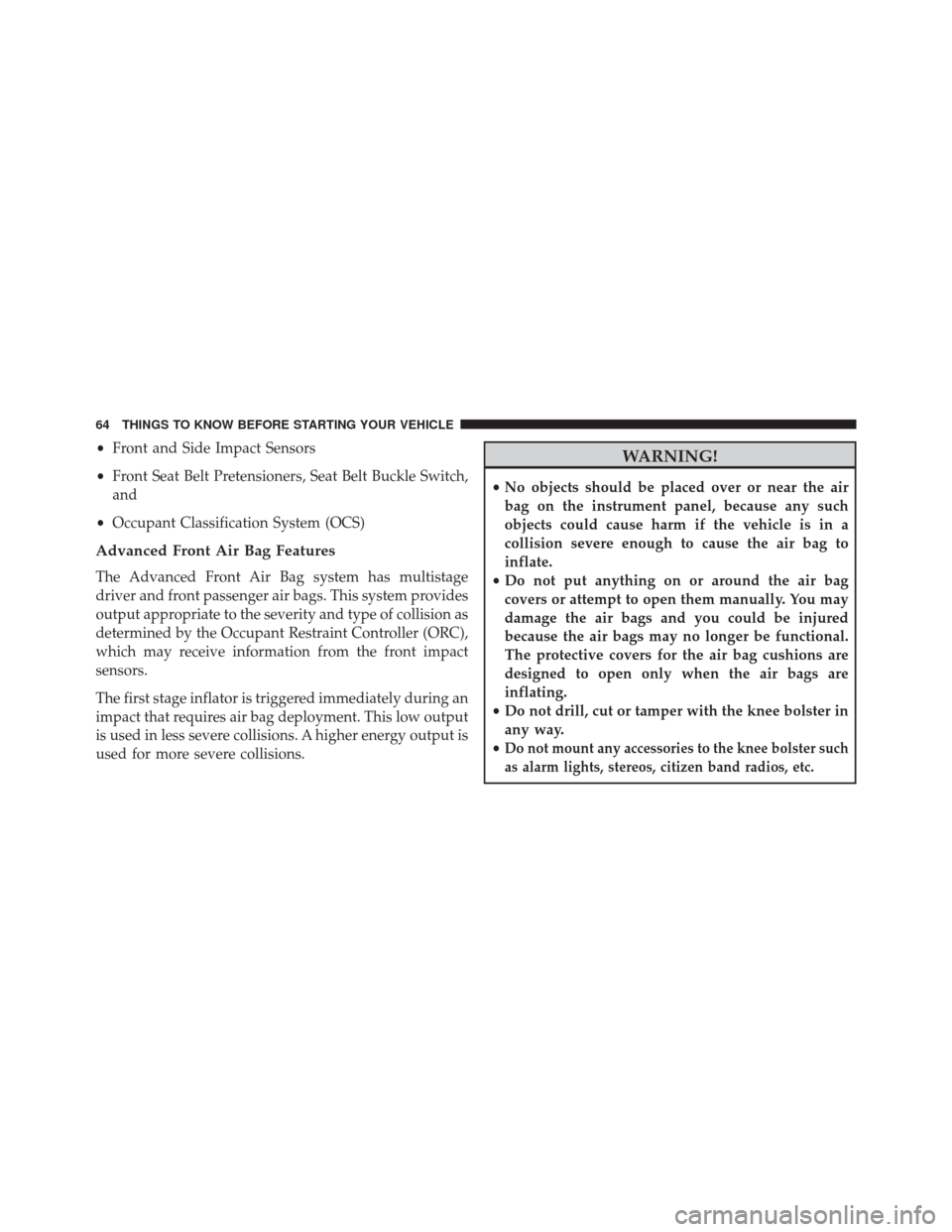
•Front and Side Impact Sensors
• Front Seat Belt Pretensioners, Seat Belt Buckle Switch,
and
• Occupant Classification System (OCS)
Advanced Front Air Bag Features
The Advanced Front Air Bag system has multistage
driver and front passenger air bags. This system provides
output appropriate to the severity and type of collision as
determined by the Occupant Restraint Controller (ORC),
which may receive information from the front impact
sensors.
The first stage inflator is triggered immediately during an
impact that requires air bag deployment. This low output
is used in less severe collisions. A higher energy output is
used for more severe collisions.
WARNING!
•No objects should be placed over or near the air
bag on the instrument panel, because any such
objects could cause harm if the vehicle is in a
collision severe enough to cause the air bag to
inflate.
• Do not put anything on or around the air bag
covers or attempt to open them manually. You may
damage the air bags and you could be injured
because the air bags may no longer be functional.
The protective covers for the air bag cushions are
designed to open only when the air bags are
inflating.
• Do not drill, cut or tamper with the knee bolster in
any way.
•
Do not mount any accessories to the knee bolster such
as alarm lights, stereos, citizen band radios, etc.
64 THINGS TO KNOW BEFORE STARTING YOUR VEHICLE
Page 68 of 656
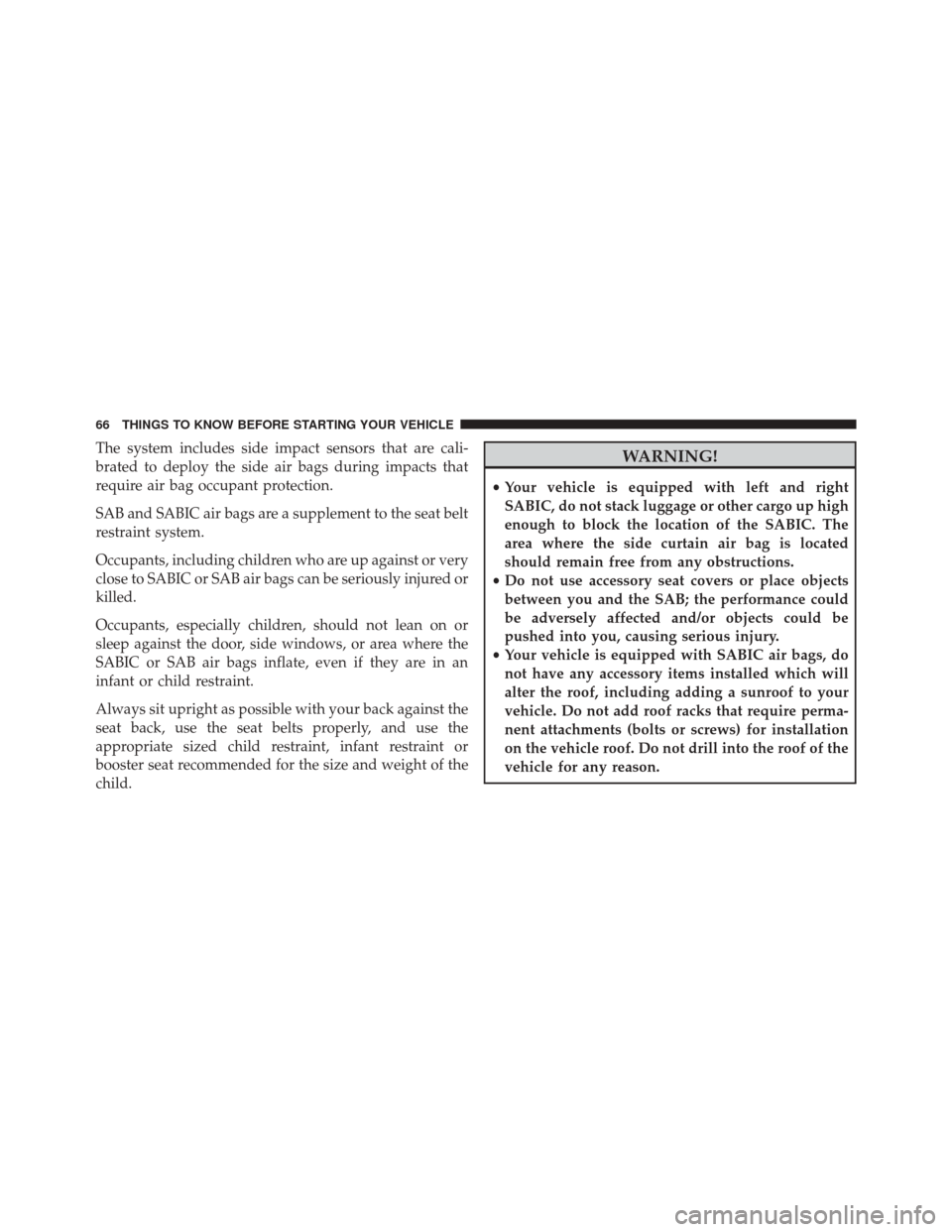
The system includes side impact sensors that are cali-
brated to deploy the side air bags during impacts that
require air bag occupant protection.
SAB and SABIC air bags are a supplement to the seat belt
restraint system.
Occupants, including children who are up against or very
close to SABIC or SAB air bags can be seriously injured or
killed.
Occupants, especially children, should not lean on or
sleep against the door, side windows, or area where the
SABIC or SAB air bags inflate, even if they are in an
infant or child restraint.
Always sit upright as possible with your back against the
seat back, use the seat belts properly, and use the
appropriate sized child restraint, infant restraint or
booster seat recommended for the size and weight of the
child.WARNING!
•Your vehicle is equipped with left and right
SABIC, do not stack luggage or other cargo up high
enough to block the location of the SABIC. The
area where the side curtain air bag is located
should remain free from any obstructions.
• Do not use accessory seat covers or place objects
between you and the SAB; the performance could
be adversely affected and/or objects could be
pushed into you, causing serious injury.
• Your vehicle is equipped with SABIC air bags, do
not have any accessory items installed which will
alter the roof, including adding a sunroof to your
vehicle. Do not add roof racks that require perma-
nent attachments (bolts or screws) for installation
on the vehicle roof. Do not drill into the roof of the
vehicle for any reason.
66 THINGS TO KNOW BEFORE STARTING YOUR VEHICLE
Page 70 of 656
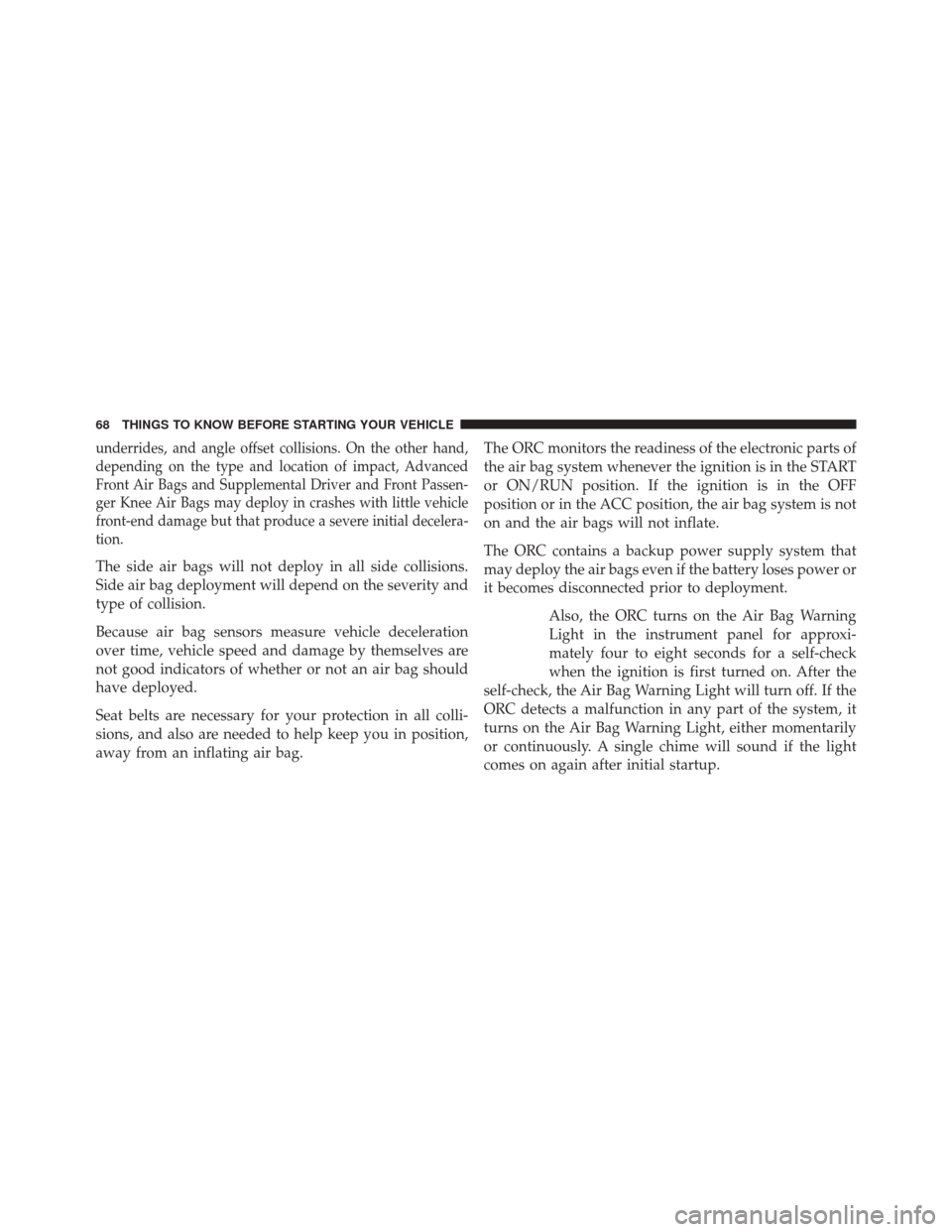
underrides, and angle offset collisions. On the other hand,
depending on the type and location of impact, Advanced
Front Air Bags and Supplemental Driver and Front Passen-
ger Knee Air Bags may deploy in crashes with little vehicle
front-end damage but that produce a severe initial decelera-
tion.
The side air bags will not deploy in all side collisions.
Side air bag deployment will depend on the severity and
type of collision.
Because air bag sensors measure vehicle deceleration
over time, vehicle speed and damage by themselves are
not good indicators of whether or not an air bag should
have deployed.
Seat belts are necessary for your protection in all colli-
sions, and also are needed to help keep you in position,
away from an inflating air bag.The ORC monitors the readiness of the electronic parts of
the air bag system whenever the ignition is in the START
or ON/RUN position. If the ignition is in the OFF
position or in the ACC position, the air bag system is not
on and the air bags will not inflate.
The ORC contains a backup power supply system that
may deploy the air bags even if the battery loses power or
it becomes disconnected prior to deployment.
Also, the ORC turns on the Air Bag Warning
Light in the instrument panel for approxi-
mately four to eight seconds for a self-check
when the ignition is first turned on. After the
self-check, the Air Bag Warning Light will turn off. If the
ORC detects a malfunction in any part of the system, it
turns on the Air Bag Warning Light, either momentarily
or continuously. A single chime will sound if the light
comes on again after initial startup.
68 THINGS TO KNOW BEFORE STARTING YOUR VEHICLE
Page 71 of 656
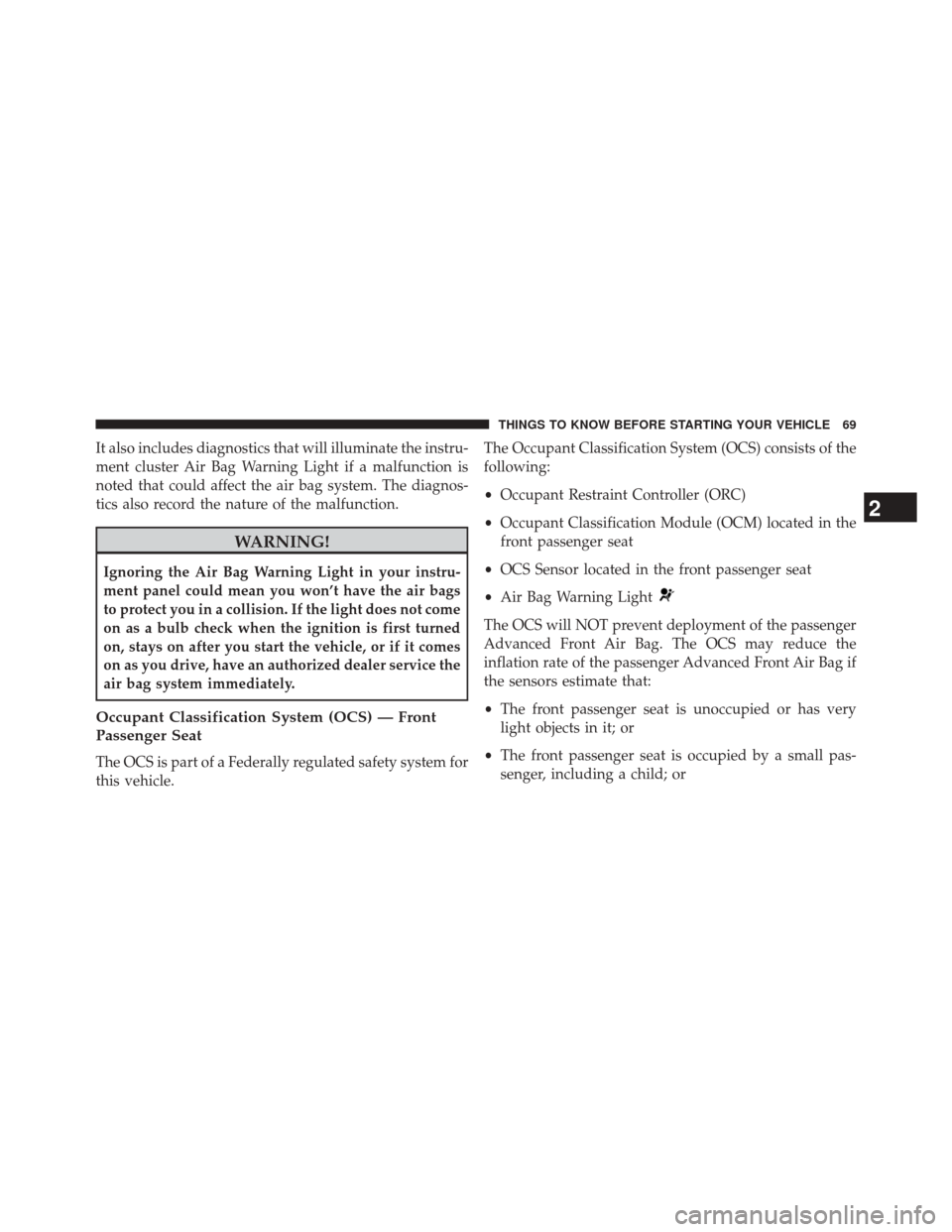
It also includes diagnostics that will illuminate the instru-
ment cluster Air Bag Warning Light if a malfunction is
noted that could affect the air bag system. The diagnos-
tics also record the nature of the malfunction.
WARNING!
Ignoring the Air Bag Warning Light in your instru-
ment panel could mean you won’t have the air bags
to protect you in a collision. If the light does not come
on as a bulb check when the ignition is first turned
on, stays on after you start the vehicle, or if it comes
on as you drive, have an authorized dealer service the
air bag system immediately.
Occupant Classification System (OCS) — Front
Passenger Seat
The OCS is part of a Federally regulated safety system for
this vehicle.The Occupant Classification System (OCS) consists of the
following:
•
Occupant Restraint Controller (ORC)
• Occupant Classification Module (OCM) located in the
front passenger seat
• OCS Sensor located in the front passenger seat
• Air Bag Warning Light
The OCS will NOT prevent deployment of the passenger
Advanced Front Air Bag. The OCS may reduce the
inflation rate of the passenger Advanced Front Air Bag if
the sensors estimate that:
•The front passenger seat is unoccupied or has very
light objects in it; or
• The front passenger seat is occupied by a small pas-
senger, including a child; or
2
THINGS TO KNOW BEFORE STARTING YOUR VEHICLE 69
Page 72 of 656
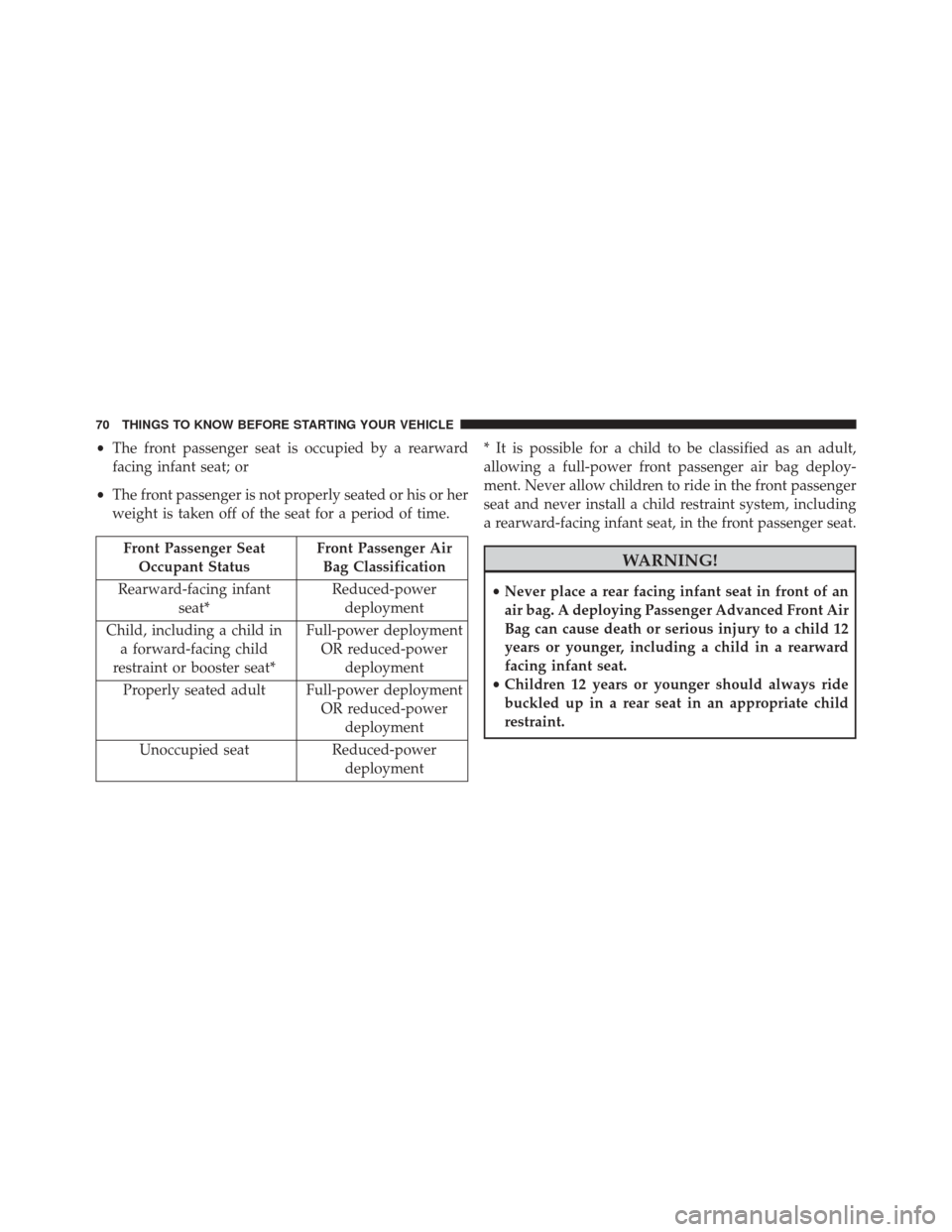
•The front passenger seat is occupied by a rearward
facing infant seat; or
• The front passenger is not properly seated or his or her
weight is taken off of the seat for a period of time.
Front Passenger Seat
Occupant Status Front Passenger Air
Bag Classification
Rearward-facing infant seat* Reduced-power
deployment
Child, including a child in a forward-facing child
restraint or booster seat* Full-power deployment
OR reduced-power deployment
Properly seated adult Full-power deployment OR reduced-powerdeployment
Unoccupied seat Reduced-power deployment* It is possible for a child to be classified as an adult,
allowing a full-power front passenger air bag deploy-
ment. Never allow children to ride in the front passenger
seat and never install a child restraint system, including
a rearward-facing infant seat, in the front passenger seat.WARNING!
•
Never place a rear facing infant seat in front of an
air bag. A deploying Passenger Advanced Front Air
Bag can cause death or serious injury to a child 12
years or younger, including a child in a rearward
facing infant seat.
• Children 12 years or younger should always ride
buckled up in a rear seat in an appropriate child
restraint.
70 THINGS TO KNOW BEFORE STARTING YOUR VEHICLE
Page 74 of 656
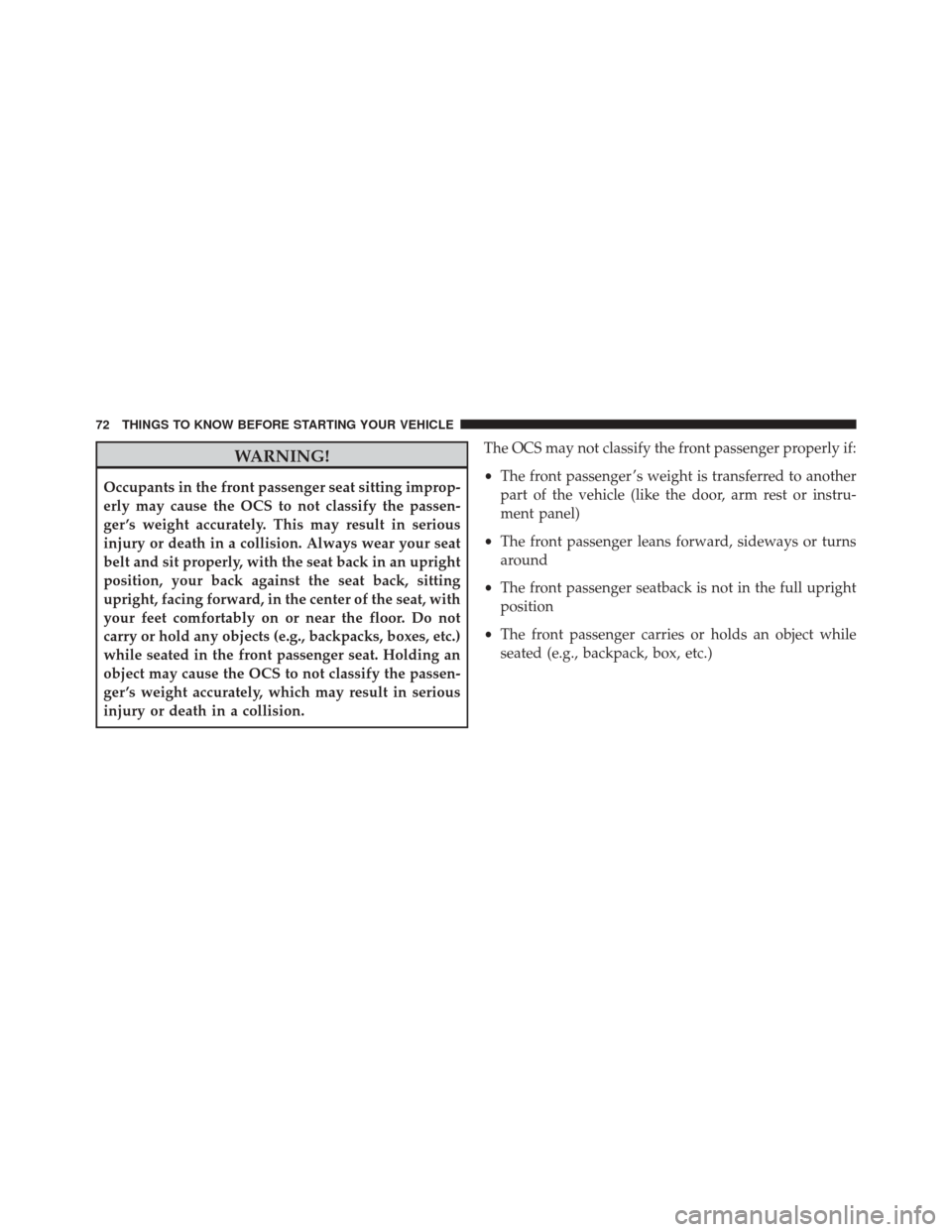
WARNING!
Occupants in the front passenger seat sitting improp-
erly may cause the OCS to not classify the passen-
ger ’s weight accurately. This may result in serious
injury or death in a collision. Always wear your seat
belt and sit properly, with the seat back in an upright
position, your back against the seat back, sitting
upright, facing forward, in the center of the seat, with
your feet comfortably on or near the floor. Do not
carry or hold any objects (e.g., backpacks, boxes, etc.)
while seated in the front passenger seat. Holding an
object may cause the OCS to not classify the passen-
ger ’s weight accurately, which may result in serious
injury or death in a collision.The OCS may not classify the front passenger properly if:
•
The front passenger ’s weight is transferred to another
part of the vehicle (like the door, arm rest or instru-
ment panel)
• The front passenger leans forward, sideways or turns
around
• The front passenger seatback is not in the full upright
position
• The front passenger carries or holds an object while
seated (e.g., backpack, box, etc.)
72 THINGS TO KNOW BEFORE STARTING YOUR VEHICLE
Page 77 of 656
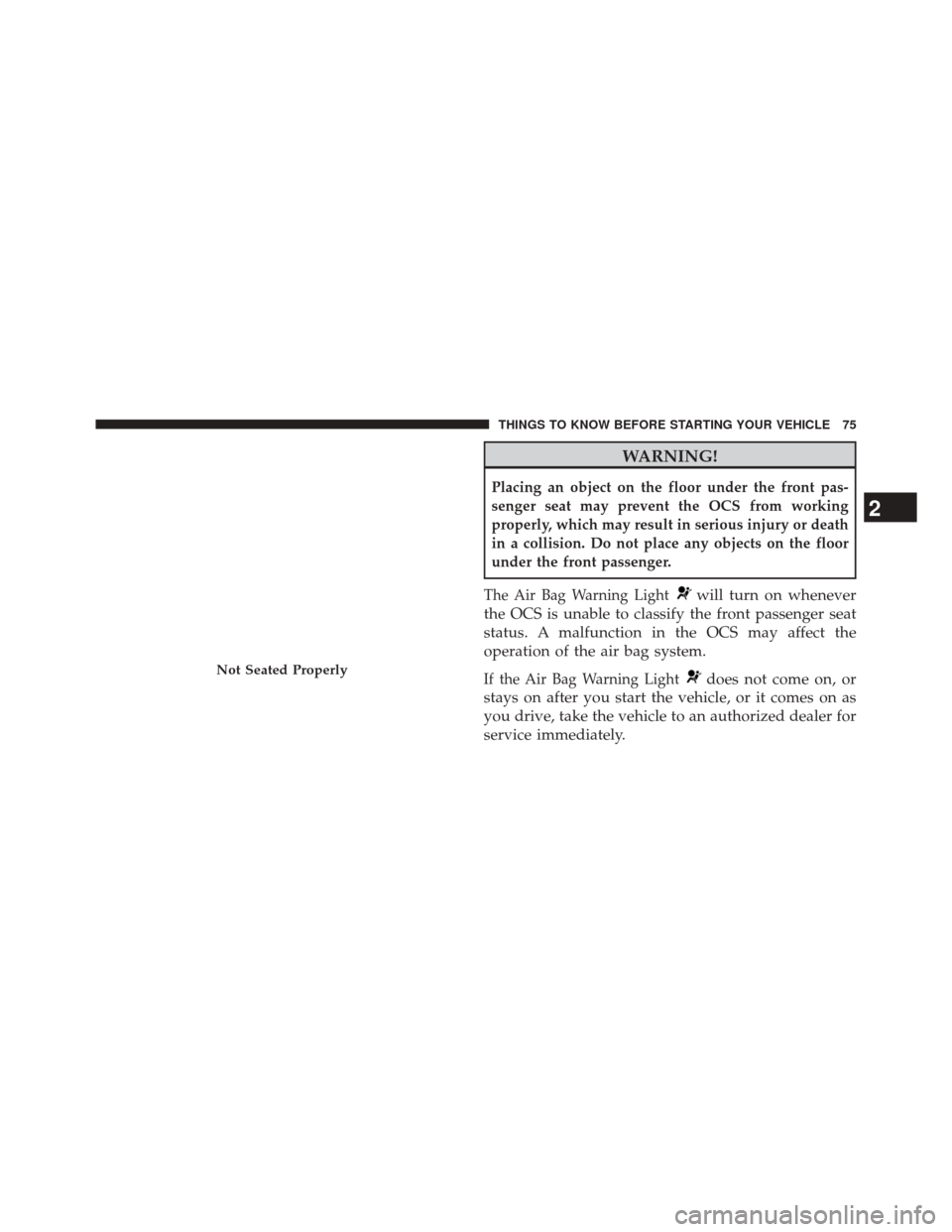
WARNING!
Placing an object on the floor under the front pas-
senger seat may prevent the OCS from working
properly, which may result in serious injury or death
in a collision. Do not place any objects on the floor
under the front passenger.
The Air Bag Warning Light
will turn on whenever
the OCS is unable to classify the front passenger seat
status. A malfunction in the OCS may affect the
operation of the air bag system.
If the Air Bag Warning Lightdoes not come on, or
stays on after you start the vehicle, or it comes on as
you drive, take the vehicle to an authorized dealer for
service immediately.Not Seated Properly
2
THINGS TO KNOW BEFORE STARTING YOUR VEHICLE 75
Page 78 of 656
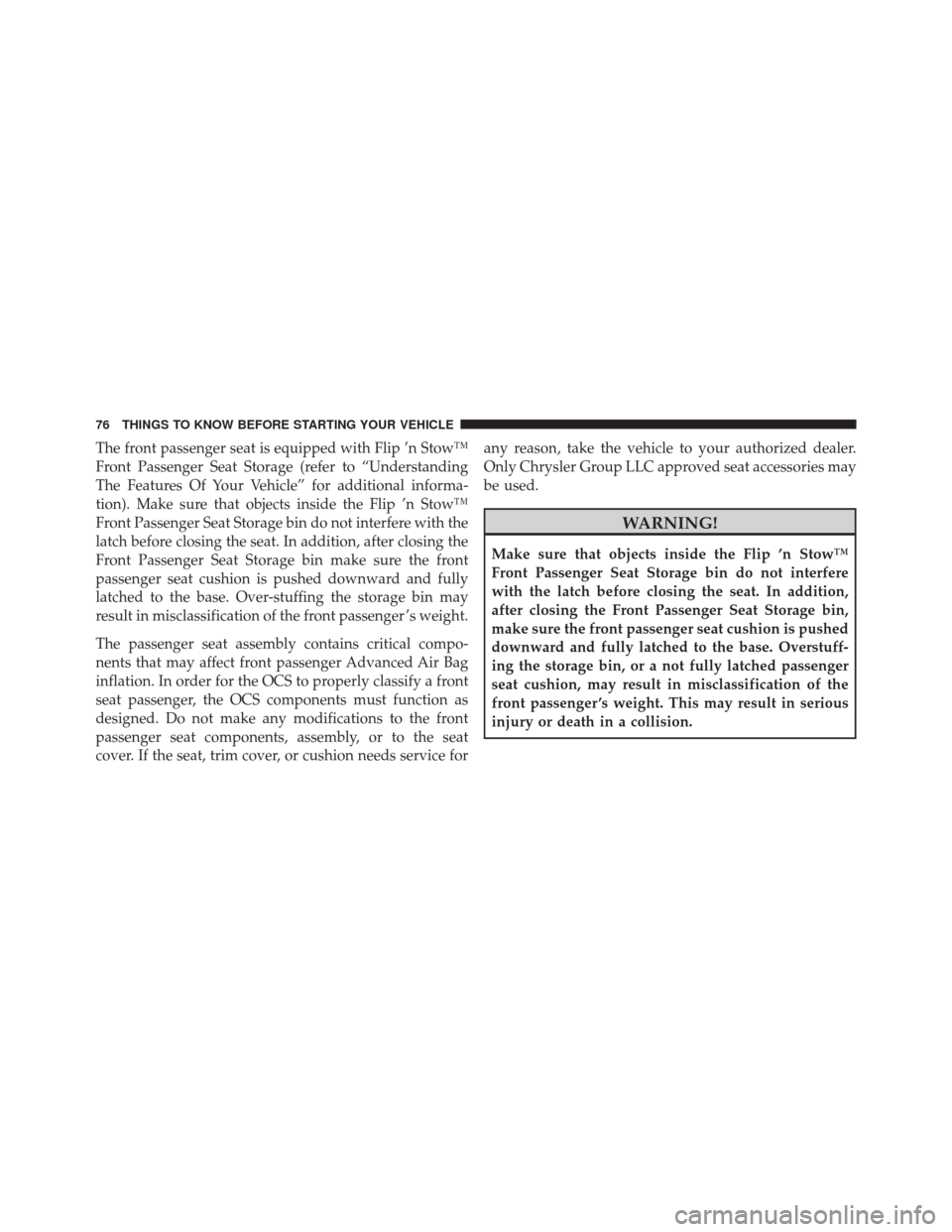
The front passenger seat is equipped with Flip ’n Stow™
Front Passenger Seat Storage (refer to “Understanding
The Features Of Your Vehicle” for additional informa-
tion). Make sure that objects inside the Flip ’n Stow™
Front Passenger Seat Storage bin do not interfere with the
latch before closing the seat. In addition, after closing the
Front Passenger Seat Storage bin make sure the front
passenger seat cushion is pushed downward and fully
latched to the base. Over-stuffing the storage bin may
result in misclassification of the front passenger ’s weight.
The passenger seat assembly contains critical compo-
nents that may affect front passenger Advanced Air Bag
inflation. In order for the OCS to properly classify a front
seat passenger, the OCS components must function as
designed. Do not make any modifications to the front
passenger seat components, assembly, or to the seat
cover. If the seat, trim cover, or cushion needs service forany reason, take the vehicle to your authorized dealer.
Only Chrysler Group LLC approved seat accessories may
be used.
WARNING!
Make sure that objects inside the Flip ’n Stow™
Front Passenger Seat Storage bin do not interfere
with the latch before closing the seat. In addition,
after closing the Front Passenger Seat Storage bin,
make sure the front passenger seat cushion is pushed
downward and fully latched to the base. Overstuff-
ing the storage bin, or a not fully latched passenger
seat cushion, may result in misclassification of the
front passenger ’s weight. This may result in serious
injury or death in a collision.
76 THINGS TO KNOW BEFORE STARTING YOUR VEHICLE